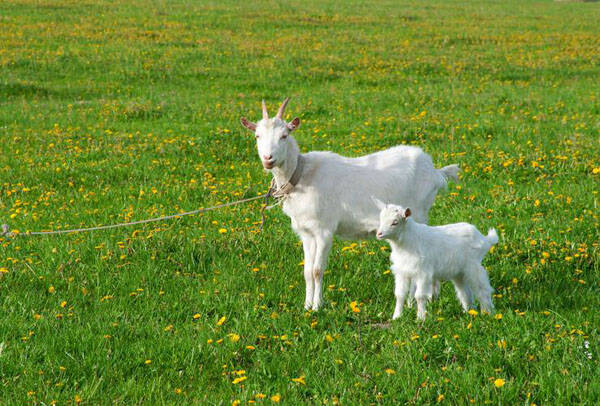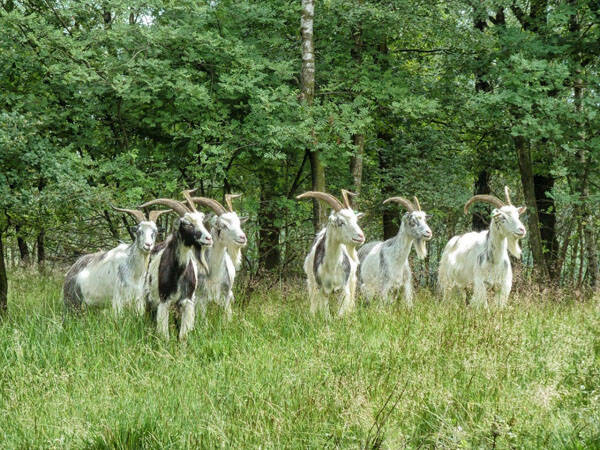Capra hircus
IUCN
LCBasic Information
Scientific classification
- name:Capra hircus
- Scientific Name:Summer sheep, black sheep, domestic goat
- Outline:Ungulata
- Family:Artiodactyla Bovidae Capra
Vital signs
- length:70-180cm
- Weight:About 50kg
- lifetime:12-18years
Feature
The most geographically widespread of all domestic animals
Distribution and Habitat
Goats are the most widely distributed of all livestock, and are distributed all over the world. According to the statistics of the Food and Agriculture Organization of the United Nations (1978), there are 435.352 million goats in the world, of which 89.1% are distributed in Asia and Africa. In terms of countries raising goats, India has the largest number of goats in the world, and China ranks second.
In China, goats are distributed in all provinces, cities, and autonomous regions across the country. Even Guangdong, Guangxi, Fujian, and Hainan, which do not raise sheep, have goats distributed. In general, my country's goat population is mainly distributed in the area north of the Yangtze River, concentrated in East China, North China, and Southwest China, and is less distributed in South China.
Appearance
Goats have thin horns, which are very long and can open to both sides. They have a "rectangular" body shape of meat livestock, with a low body, plump muscles all over the body, and a delicate and loose body shape. The body surface is covered with hair fibers of different lengths, colors, patterns and curls.
Generally, the body length of male goats is 85-95cm, the body length of female goats is 70-85cm, and the body length of markhor goats is 140-180cm.
Different breeds of goats have different weights. An adult goat weighs about 100 kilograms, and after slaughter, it can produce about 60 kilograms of meat and about 20 kilograms of bones.
Details
Goats (scientific name: Capra hircus) are one of the earliest domesticated livestock by humans.

Modern goats are domesticated from wild goats. Archaeological excavations have shown that goats in Central and West Asia were domesticated as livestock as early as 5700 BC. Since goats belong to one of the weaker families in the animal kingdom, they became the first domesticated animals by humans, so there is no definite answer to the question of their origin. It is generally believed that wild goats became domestic goats as early as the Neolithic Age (8,000-10,000 BC). Most scholars believe that the ancestors of domestic goats may be Prisca sheep (Capra Prisca), horned (sheep bone) sheep (Capra aegagrus), (sheep bone) sheep (Capra falconeri) and Tahr sheep (Capra jemaaica) and European wild sheep. The important ancestors of modern goats are horned (sheep bone) sheep, (sheep bone) sheep and European wild sheep.
China has a long history of goat breeding, and there are written records of goat breeding as early as the Xia and Shang dynasties. More than a thousand years ago, goats were mainly raised in southern my country, and then gradually formed a scale. Goat production has the characteristics of high reproduction rate, strong adaptability and easy management, and is widely raised in my country's vast agricultural and pastoral areas. Over the past 20 years of reform and opening up, my country's goat industry has developed rapidly and achieved remarkable results. However, due to the destruction of the ecological environment, in recent years, Inner Mongolia, Liaoning, Xinjiang and other major goat breeding areas have successively implemented a series of grazing ban and grazing restrictions, summarizing the ecological goat breeding program that not only achieves ecological environmental protection but also promotes the development of the goat industry, which has brought my country's goat breeding industry into a new turning point.
Goats have strong mobility. In the summer when water and grass are lush, the activity radius of goats is about 3 kilometers; in the winter when water is cold and grass is dry, the activity radius of goats can reach as far as 6 kilometers. Strong mobility can ensure that goats get more and better feed than other livestock to meet their nutritional needs. Goats are more naughty, and running, jumping and climbing are their unique biological characteristics. In the shed, goats like to stand, lie down and rest at high places; on the mountain, goats can walk freely on steep rock slopes and even cliffs that other livestock cannot climb; goats can also stand upright on their two hind legs and fully eat higher thorny shrubs and grass. Goats have a wide range of diets, especially young leaves from branches. In a day, 90% of their food is leaves. The salivary glands of goats secrete a large amount of tannins in plants, which can neutralize and detoxify them, ensuring that goats can eat a large amount of protein-rich leaves, effectively digest, absorb and utilize them without being affected by the toxic side effects of tannins. Goats like dryness and cleanliness. Drinking water, forage, feed, and utensils should always be kept clean and hygienic. The brave and aggressive habits of goats help them defend against enemies, but also increase the difficulty of management. In production, measures such as separate enclosures or dehorning can be taken according to specific circumstances. Goats have strong reproductive capacity. Three generations of grandparents and grandchildren can be seen in one year. They have multiple births and are prolific. Most of them have three births in two years, and each birth has two lambs.

The formation of goat breeds is closely related to the development of social economy, people's living needs and ecological conditions. There are more than 150 major goat breeds and breed groups in the world. They are classified mainly according to production direction and are generally divided into six categories: ① Cashmere goats, such as Liaoning Cashmere goats and Cashmere goats; ② Fur goats, such as Jining Qing goats, Zhongwei goats, Ethiopian lamb goats, etc.; ③ Meat goats, such as Matou goats and Boer goats; ④ Fur goats, such as Angora goats and Soviet wool goats; ⑤ Dairy goats, such as Guanzhong dairy goats, Saanen goats, and Toggenburg goats; ⑥ Dual-purpose goats (also known as ordinary goats), such as Xinjiang goats.
There are 20 goat breeds in my country listed in the "Chinese Sheep Breeds". These local breeds have many excellent traits, such as high fertility, good meat quality, fine wool, good quality, high yield, and special production performance for board skin, lamb skin, fur, and milk. In recent years, my country has introduced famous wool Angora goats, meat Boer goats and Saanen dairy goats from abroad on the basis of these local fine breeds, and hybridized and improved them with local breeds, breeding nearly 20 new breeds such as Nanjiang Yellow Sheep, Guanzhong Dairy Goat, Laoshan Dairy Goat, etc.
In the development of human civilization, goats provide humans with meat, milk, leather, wool and other main living materials, and play an important role in human agricultural civilization and economic development. In addition, goats play an important role in culture and religious beliefs as sacrificial offerings. Goats are also one of the twelve Chinese zodiac signs (but most people think that sheep are one of the twelve Chinese zodiac signs). In superstition, people born in the year of the sheep are shy, introverted, creative, and perfectionists.
Protect wild animals and stop eating game.
Maintaining ecological balance is everyone's responsibility!








